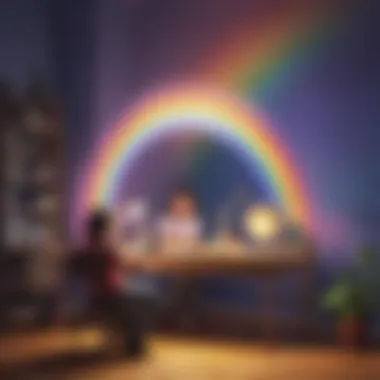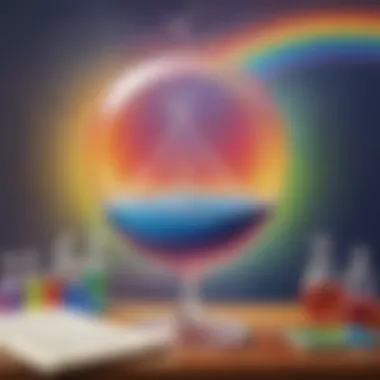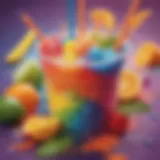Engaging Rainbow Science Activities for Young Minds


Science Fun Facts
Discover the fascinating world of rainbows through intriguing scientific trivia and quirky facts. Did you know that rainbows were first explained by the brilliant scientist Sir Isaac Newton? Dive deeper into the science of colors and light with amazing rainbow-related records and thought-provoking questions, sparking curiosity in young minds.
Discover the Wonders of Science
Embark on a colorful journey exploring the wonders of science and rainbows. Uncover various scientific concepts behind the formation of rainbows, enhanced through engaging educational videos, animations, and interactive learning tools. Witness the real-life applications of science through the beautiful phenomenon of rainbows, connecting abstract theories to everyday experiences.
Science Quiz Time
Test your knowledge with interactive rainbow-themed quizzes designed to challenge young science enthusiasts. Engage in multiple choice questions, brain teasers, and fun puzzles that foster learning through gamification. From understanding the optics of rainbows to exploring the intricacies of light refraction, these quizzes offer an interactive and exciting way to deepen scientific understanding.
Science Experiment Showcase
Immerse yourself in a world of colorful and educational science experiments focused on rainbows. Follow step-by-step instructions to conduct fun and engaging experiments that illustrate the principles of light and color. Access a comprehensive materials list to ensure you have everything you need for your rainbow experiments, along with essential safety tips and precautions to guarantee a secure scientific exploration.
Introduction
In this section on the fascination with rainbows, it is imperative to understand the profound impact of such mesmerizing natural phenomena on young minds. Rainbows symbolize a blend of science and artistry, captivating the imagination of children aged 6-12. Through a series of engaging rainbow activities, youngsters can delve into the realm of colors, light, and scientific principles, fostering a sense of wonder and inquiry.
Under the umbrella of understanding rainbows, two crucial aspects come into play - The Science Behind Rainbows and The Cultural Significance of Rainbows. Both facets offer unique perspectives that contribute to the overall charm and educational value of these colorful arcs in the sky.


The Science Behind Rainbows
The Science Behind Rainbows unfolds a fascinating narrative that merges physics and optics seamlessly. By unraveling the intricate processes of light refraction, dispersion, and reflection, children embark on a journey of exploration into the scientific foundations of these ethereal displays. Through hands-on experiments and observations, budding scientists comprehend how sunlight interacts with water droplets to form the seven distinct colors of the spectrum seen in a rainbow.
One key characteristic that sets The Science Behind Rainbows apart is its ability to demystify a natural phenomenon that often seems magical to young minds. By breaking down complex scientific concepts into accessible explanations, this aspect not only educates but also inspires curiosity and critical thinking among children. Understanding the science behind rainbows empowers young learners to question, experiment, and seek answers, laying a solid foundation for future scientific endeavors.
The Cultural Significance of Rainbows
On the other hand, delving into The Cultural Significance of Rainbows opens a doorway to the historical, symbolic, and artistic value attributed to these colorful arches across different societies and time periods. Exploring how various cultures interpret rainbows as symbols of harmony, diversity, or even spiritual significance enriches the understanding of these natural wonders beyond their scientific explanation.
A significant advantage of including The Cultural Significance of Rainbows in this article lies in broadening young minds beyond the scientific realm. By appreciating the cultural contexts and historical viewpoints related to rainbows, children develop a holistic understanding of these phenomena, nurturing empathy, tolerance, and cultural appreciation. This dual approach of blending science with culture paves the way for a comprehensive and enriching exploration of rainbows that transcends academic boundaries.
Rainbow Experiments
Rainbow experiments play a crucial role in expanding young minds' scientific horizons. By engaging in these experiments, children not only get to witness the fascinating interplay of light and color but also develop a deeper understanding of scientific concepts in a hands-on manner. These experiments serve as a gateway to nurturing a curiosity for the natural world and encourage critical thinking and problem-solving skills. Additionally, rainbow experiments spark creativity and imagination, making learning a fun and immersive experience for young science enthusiasts.
Exploring Light and Color
Prism Play
Prism play is a fundamental aspect of exploring light and color in the context of rainbow activities. This activity involves using a prism to break down white light into its constituent colors, showcasing the visible spectrum. The key characteristic of prism play lies in its ability to vividly demonstrate the phenomenon of dispersion, where light waves are separated based on their wavelengths. This engaging and interactive experiment not only introduces children to the concept of refraction but also allows them to create their mini rainbow, fostering a hands-on learning experience. Despite its simplicity, prism play serves as a powerful tool for illustrating complex optical principles in a straightforward and accessible manner within this article.
Splitting Light with Water


Splitting light with water is another intriguing method to explore light and color within the realm of rainbow activities. By using a transparent container filled with water, children can observe how light bends, refracts, and creates a spectrum of colors. The key characteristic of this activity lies in its simplicity and effectiveness in demonstrating the behavior of light in a liquid medium. Splitting light with water offers a mesmerizing visual representation of optical phenomena, allowing young learners to grasp the concept of color separation effortlessly. While this experiment may have some limitations in precision due to environmental factors, its hands-on nature and visual appeal make it a valuable addition to this article's collection of rainbow experiments.
Rainbow Projects
Rainbow Projects play a crucial role in this article, serving as hands-on activities that allow young Science enthusiasts to delve deeper into the colorful world of rainbows. These projects are designed to stimulate creativity, critical thinking, and an understanding of the principles of light and color. By engaging in Rainbow Projects, children aged 6-12 can apply scientific concepts in a fun and interactive manner, fostering a sense of curiosity and exploration. The benefits of Rainbow Projects extend beyond mere entertainment; they also encourage young minds to develop problem-solving skills, enhance their understanding of scientific phenomena, and nurture a lifelong love for learning.
Building a Rainbow in a Jar
Gather Your Materias
Gathering the materials for building a rainbow in a jar is a pivotal step in this creative and educational activity. The key materials required include a clear glass jar, light corn syrup, water, food coloring in various hues, and a light source. These materials are carefully chosen to facilitate the formation and visualization of distinct rainbow layers within the jar. The clear glass jar allows for easy observation of the layers, while the light corn syrup and water help create the density gradient necessary for the rainbow effect. Food coloring adds vibrant colors, mimicking the natural beauty of a rainbow. The unique feature of these materials lies in their compatibility and ease of manipulation, making them ideal choices for this project.
Assembling the Rainbow Layers
Assembling the rainbow layers is the core activity of building a rainbow in a jar. It involves carefully layering liquids of varying densities to simulate the stratification of colors in a rainbow. The key characteristic of this process is the precise pouring and stacking of colored liquids in the jar to create distinct, non-mixing layers. This technique allows young learners to visually experience how light interacts with different mediums, leading to the formation of a rainbow. The unique feature of layering liquids in the jar is its potential for experimentation and observation, offering children a hands-on way to explore scientific principles such as refraction and color separation. While this process may require patience and precision, its advantages in enhancing children's understanding of light and color phenomena outweigh any challenges, providing a valuable learning experience.
Rainbow Slime Science
Mixing Colors
Mixing colors is a fundamental aspect of Rainbow Slime Science, contributing to the exploration of color theory and chemical reactions. In this activity, children blend different colored slimes to create new shades and hues, sparking their creativity and understanding of color combinations. The key characteristic of mixing colors in slime science is the tactile and sensory experience it offers, allowing young scientists to observe firsthand how primary colors blend to form secondary and tertiary colors. This hands-on approach not only reinforces color mixing concepts but also promotes motor skills and cognitive development. The unique feature of color mixing lies in its ability to captivate children's attention and stimulate their imagination, making learning about colors both engaging and memorable.


Exploring Viscosity
Exploring viscosity in Rainbow Slime Science introduces young learners to the concept of thickness and flow in materials. By adjusting the ratios of ingredients in slime recipes, children can observe how viscosity affects the texture and stretchiness of the slime. The key characteristic of exploring viscosity is the opportunity for children to engage in sensory play while learning about scientific principles. Understanding viscosity allows kids to make predictions about the behavior of different slime consistencies and compare their observations. The unique feature of exploring viscosity in slime science is its multisensory nature, combining visual, tactile, and proprioceptive feedback to deepen children's comprehension of material properties. Despite potential challenges in handling different slime textures, the advantages of exploring viscosity lie in its hands-on exploration of a key scientific concept, promoting active learning and discovery.
Rainbow Challenges
Rainbow Challenges section brings a unique opportunity to explore the vibrant world of challenges through the lens of rainbows. Engaging in Rainbow Challenges promotes critical thinking, problem-solving skills, and scientific curiosity among young science enthusiasts aged 6-12. By participating in these challenges, children can delve deeper into the science behind rainbows while nurturing a sense of creativity and exploration. These challenges serve as a gateway to understanding light, color, and optical phenomena in an interactive and hands-on manner, making learning both fun and educational.
The Rainbow Skittle Challenge
Setting Up the Experiment
Setting up the experiment for the Rainbow Skittle Challenge involves arranging Skittles in a pattern around the edge of a plate and carefully pouring warm water into the center. This setup allows for the colors of the Skittles to diffuse into the water, creating a stunning rainbow effect. The arrangement of the Skittles and the addition of warm water initiate a colorful reaction, illustrating the concept of color mixing and diffusion in a captivating way. This experiment not only showcases a visually appealing transformation but also provides an engaging way to explore how colors blend and spread, sparking curiosity and understanding in young minds.
Observing Color Diffusion
Observing color diffusion during the Rainbow Skittle Challenge enables children to witness the gradual spread of color from the Skittles into the water, creating mesmerizing patterns and hues. This process allows participants to observe how the colors mix and move through the water, demonstrating principles of diffusion and concentration gradients. By closely monitoring the color diffusion happening in real-time, children can develop observational skills and scientific inquiry. This hands-on activity encourages active engagement with scientific concepts related to color blending and diffusion, fostering a deeper appreciation for the wonders of optics and the natural world.
Conclusion
Inspiring Curiosity through Rainbow Adventures
Encouraging Scientific Exploration
Delving into the realm of Encouraging Scientific Exploration within the context of rainbow activities offers young learners a unique opportunity to delve deeper into the principles of science. By encouraging hands-on experimentation and observation, this aspect emphasizes the importance of critical thinking and problem-solving skills. Children are prompted to ask questions, make hypotheses, and test their theories, fostering a scientific mindset that is crucial for their intellectual development. The interactive nature of scientific exploration through rainbow adventures ignites a sense of curiosity and inquiry, paving the way for young enthusiasts to become lifelong learners with a passion for discovery.
Fostering a Love for Learning
Exploring the facet of Fostering a Love for Learning in the spectrum of rainbow activities holds immense significance in igniting a child's enthusiasm for acquiring knowledge. By engaging children in interactive, educational experiences centered around rainbows, a love for learning is cultivated through exploration, discovery, and hands-on participation. This aspect emphasizes the joy of acquiring new skills and insights, instilling a sense of accomplishment and curiosity in young learners. Fostering a love for learning through rainbow adventures not only enhances a child's cognitive abilities but also nurtures a positive attitude towards education, setting a solid foundation for future academic success and personal growth.







